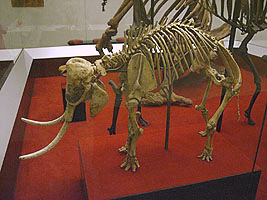Island dwarfism facts for kids
Island dwarfism, also called insular dwarfism, is when large animals become much smaller over many generations. This happens because their living space is limited, often on islands.
Imagine a big animal like an elephant. If a group of these elephants ends up on a small island, they might start having smaller babies over time. This is because there isn't enough food or space for huge animals. So, the smaller ones are more likely to survive and have babies.
This process has happened many times in history. For example, some dinosaurs like Europasaurus became smaller. Modern animals like elephants and their relatives have also shown island dwarfism. It's not just on traditional islands. It can also happen in other isolated places like caves, desert oases, or isolated mountains.
This idea is part of a bigger rule called the "island rule." It means that when animals from a mainland move to an island, small species might grow larger. This could be because there are fewer predators on the island. But large species often become smaller because food is harder to find.
Contents
Why Animals Become Smaller on Islands
There are a few reasons why animals might get smaller on islands.
Limited Food and Space
One main reason is that a smaller area means less food. If animals are stuck on an island and food starts to run out, the smaller animals have a better chance of surviving. They need less food and less space. This is a type of natural selection. Over time, only the smaller animals survive and have babies.
Being smaller also helps with having babies. Smaller animals often have shorter gestation periods (how long a baby grows inside its mother). They also have shorter generation times, meaning they can have babies more quickly.
Prey Size for Carnivores
For meat-eating animals (carnivores), the main reason for dwarfism is often the size and amount of available prey. For example, some tiger snakes on islands are smaller. This is because the only prey available to them are smaller than what mainland snakes usually eat. Since snakes generally prefer prey that matches their body size, smaller snakes are better at catching smaller prey.
Naming the Rule
The idea that small species appear on islands is known as Foster's Rule. It was first mentioned by a scientist named van Valen in 1973.
Images for kids
See also
 In Spanish: Enanismo insular para niños
In Spanish: Enanismo insular para niños



